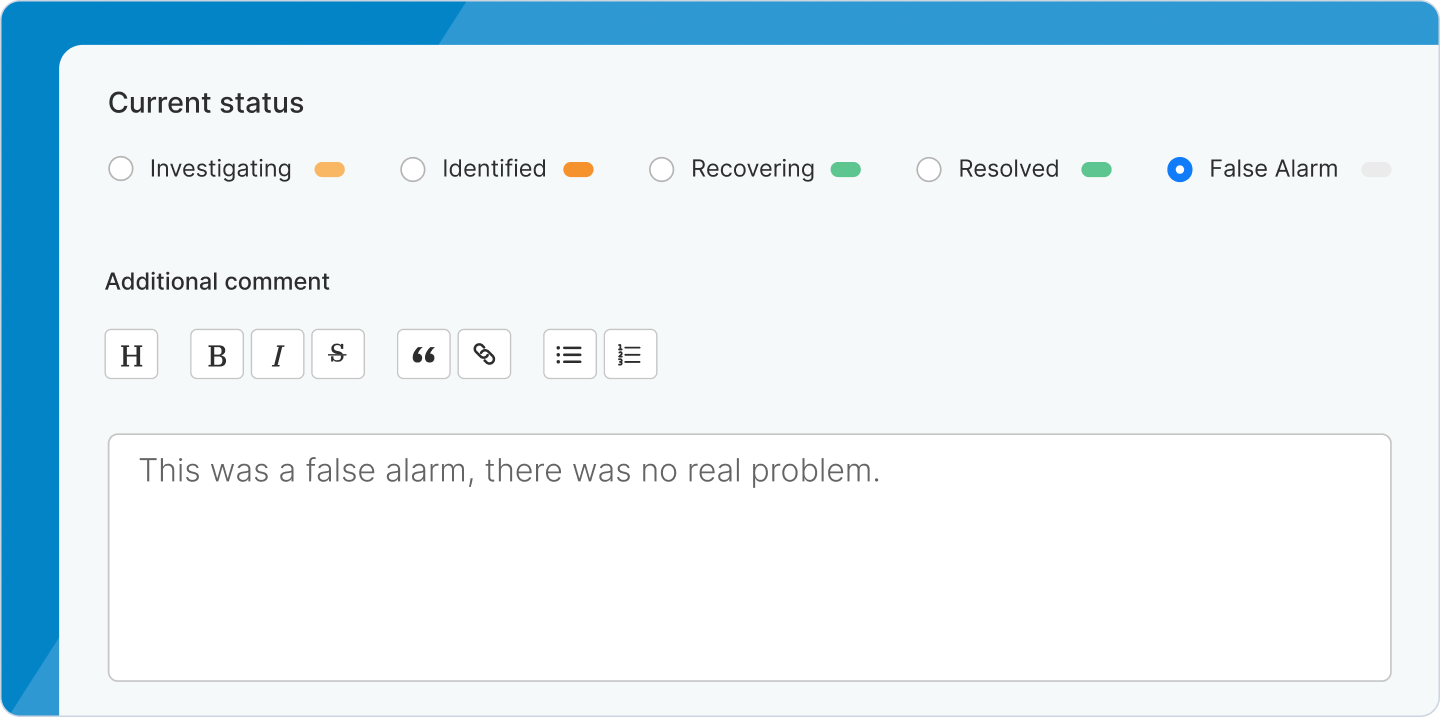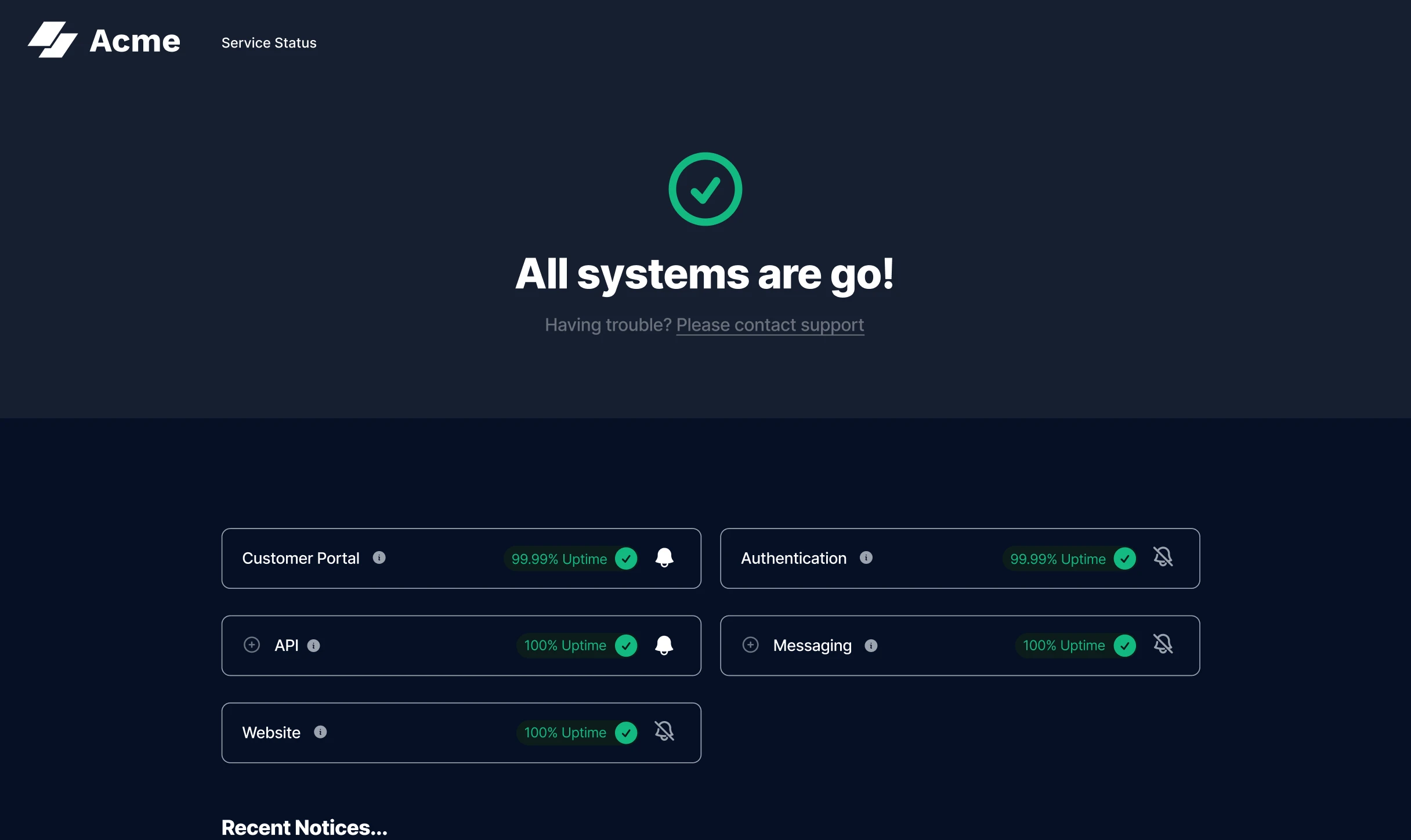False alarms in incident management: how to minimize chaos and build trust
 Jake Bartlett · 6-minute read
Jake Bartlett · 6-minute read
In January 2025, the Los Angeles area suffered from multiple wildfires that destroyed thousands of homes and cost the lives of 29 people. The city's response has received a lot of controversy, but a significant error exacerbated the issue: an erroneous evacuation alert was sent to 10 million residents.
While false alarms in IT and software incident management may not send people running for safety, they can still create chaos, lead to alert fatigue, wasted resources, and lost trust. This incident underscores the importance of accurate incident communication and the cost of false alarms.
In this article, we examine the impact of false alarms, share practical strategies to minimize them, and discuss how to respond if your alerts create unnecessary panic. Let's get started!
Types of false alarms in incident management
In the world of technology, false alarms can be caused by internal monitoring systems or public status updates.
Internal alerts (false positives in monitoring)
Monitoring systems are meant to monitor your system's infrastructure closely and notify your team when something is wrong. Despite best efforts, these systems aren't perfect; sometimes, they send alerts for issues that don't exist.
False positives in monitoring can be caused by a variety of things, such as:
- Misconfigured thresholds
- Non-critical issues escalating to high-priority alerts
- Outdated monitoring rules
- Dependency issues triggering redundant alerts
Example: A SaaS company's monitoring system detects a brief slowdown in response times and mistakenly alerts the SRE team of a major outage, resulting in internal panic and wasted time.
Unfortunately, these false positives can cause alert fatigue and desensitization among engineers, leading to slower response times, missed critical incidents, wasted resources, and decreased trust in monitoring systems.
Public false alarms (incorrect status updates and miscommunication)
Monitoring systems are meant to monitor your system's infrastructure closely and notify your team when something is wrong. Despite best efforts, these systems aren't perfect; sometimes, they send alerts for issues that don't exist.
False alarms aren't just an internal issue caused by monitoring errors. They can also impact customers, partners, and the public when incorrect status updates or miscommunication occur. Public false alarms in incident management can take many forms, including the following:
- Premature incident declaration before full verification
- Over-escalation of minor issues / mis-classification of an incident
- Accidental status page updates declaring a false outage
Example: A payment processing platform experiences transaction delays due to a third-party banking issue. A support engineer mistakenly posts a major outage on the status page, despite the system remaining operational but running slower than usual.
Public false alarms cause chaos internally and externally. Customers might flood the support queue with tickets asking for more information, leaving your support team overwhelmed and customers confused, which ultimately erodes trust and increases burnout.
How to combat false alarms from internal alerting
False positives are inevitable. There will always be a chance of errors or misinterpretations, as no system is perfect. However, there are strategies for reducing the frequency of false alarms caused by erroneous monitors and alerts.
Fine-tune monitoring thresholds
Modern monitoring systems allow you to set thresholds when key metrics reach specific values, indicating something might be wrong. Keeping monitoring thresholds up-to-date takes time and effort and requires ongoing maintenance, but it's imperative to reduce the occurrence of false positives.
Many monitoring and alerting tools today use AI to create dynamic thresholds. These thresholds allow the monitoring tool to learn the expected behavior of systems over various timeframes. They are "smarter" than static thresholds, as the system can react to different baselines it identifies in real time.
Sorry™ integrates with leading monitoring platforms, such as New Relic and Pingdom. This allows you to connect your status page components to dynamic monitor checks.
Contextual alerting and deduplication
One of the biggest challenges in incident management is dealing with redundant alerts that stem from a single root cause. Without proper correlation, a minor issue in one service can trigger a flood of alerts across dependent systems, making it difficult to identify the actual problem.
To combat this, SRE teams can implement contextual alerting and deduplication to filter out unnecessary noise. Grouping multiple alerts related to the same root cause allows teams to focus on the actual issue instead of chasing down false leads. This approach improves incident response efficiency and helps maintain trust in the alerting system by reducing false alarms.
Regularly review and update alerts
Without regular adjustments to monitors and alerts, software teams risk being overwhelmed by excessive noise or missing critical incidents due to incorrect thresholds. In the spirit of continuous improvement, SREs and on-call engineers should conduct retrospectives on false alarms just as they do for actual incidents, ensuring monitors and alerts are up-to-date.
Furthermore, incident response teams should aim to avoid the same false alarm happening again by looking for overly sensitive rules and correcting them as they happen. This continuous refinement process helps create a more reliable and actionable alerting system which reduces noise, improves response times, avoids burnout, and keeps engineers focused on real issues.
How to prevent public false alarms in incident communication
Erroneous internal alerts and poor monitoring configurations can cause a lot of internal chaos. Sometimes, these situations can even lead to a public false alarm. Human error and a lack of structure in your incident communication process can also cause false alarms. Here are some ways to prevent public false alarms in incident communication.
Verify incidents before publishing status updates
There's a fine line between communicating quickly and ensuring you're not causing panic for no reason. Verify the incident before publishing an incident report to customers so you can communicate confidently without creating chaos.
For example, let's say you receive a report from a customer that they're getting an error when they try to log in. Upon further investigation, you learned the customer's network connection was spotty, which caused the error. You may have jumped the gun and posted an incident notice without verifying the incident.
Verifying incidents might be as simple as running a quick functional test to replicate a customer issue, or it might involve diving deeper into logs and metrics. Regardless, always verify the incident before reporting anything publicly. That doesn't mean you need to know the cause of the incident, but you should confirm there is indeed an issue impacting customers.
Set up controlled communication pipelines
It's imperative to have the right systems and processes for incident communication. These include internal channels for quickly communicating with your team during the verification process, and public channels for reaching your customers.
Segment your communications so you don't cause unaffected customers to panic. This can lead to more work and deteriorate trust in your incident communication process. For example, Sorry™ allows you to notify the right people by selecting the components impacted by a given incident.
Following a tiered communication process can also help ensure you're not creating false alarms with customers for minor issues that impact a small subset of users. For example, you might only communicate incidents publicly once a certain level of impact is confirmed.
Train teams and maintain tools
Train new hires on the importance of incident communication and ensure key players understand their roles and responsibilities. Set expectations for how and when incidents are communicated to prevent delays and avoid false alarms.
Maintain your public communication channels so they're reliable when needed. Run mock incidents regularly to identify areas that might need maintenance. Otherwise, you might send an incident notice to a broader audience than intended (as with the California fires).
Use clear language
Vague or incorrect language can confuse customers and cause more problems than providing no communication. Here are two status updates that illustrate clear and accurate language vs. vague and unclear language that can cause panic.
✅Good status update:
"We're aware of increased transaction processing times due to a delay with one of our banking partners. Payments are still being processed, but some may take longer than usual. Our team is monitoring the situation, and we'll provide updates as we learn more. Thank you for your patience."
❌Bad status update:
"Our payment system is down. Transactions may not go through. Stay tuned for updates."
The first update provides straightforward, actionable information that reassures customers, while the second creates unnecessary panic and leaves customers with more questions than answers.
False alarms happen
Every incident response team will experience false alarms, whether internal alerting issues, public panic, or both. False alarms happen, and they offer valuable opportunities for improvement.
Teams can reduce the frequency and impact of false alarms by reviewing and refining alerting processes, ensuring clear communication, and using tools that help manage incidents efficiently. The key is learning from them, adjusting systems accordingly, and maintaining trust with internal teams and customers.
If you find yourself in a scenario where you've created a false alarm for customers, simply acknowledge it. Be transparent about how it happened and what you're doing to avoid it from happening again. Don't hide the false alarm as that will only cause more confusion for customers.
Using Sorry™ to handle false alarms
Incident management teams worldwide use Sorry™ to communicate with customers in a structured way during incidents, including false alarms. We understand that false alarms happen, so we've baked that into our product.
If you mistakenly publish an incident notice in Sorry™, don't stress. Instead of deleting the incident report, you can easily update the incident to indicate it was a false alarm.

Deleting the incident report could cause confusion, whereas updating the status to "false alarm" keeps a clear audit trail of all incidents, including erroneous reports. This prevents unnecessary panic by quickly correcting the incident report and improves customer transparency by showing an issue was identified and later confirmed as non-critical.
Interested in learning how Sorry™ can help your team improve incident communication and build transparency around false alarms? Schedule a demo with us today!
Interested in improving your incident communication process?
We provide the easiest status page tool for handling incident communication through multiple channels.
